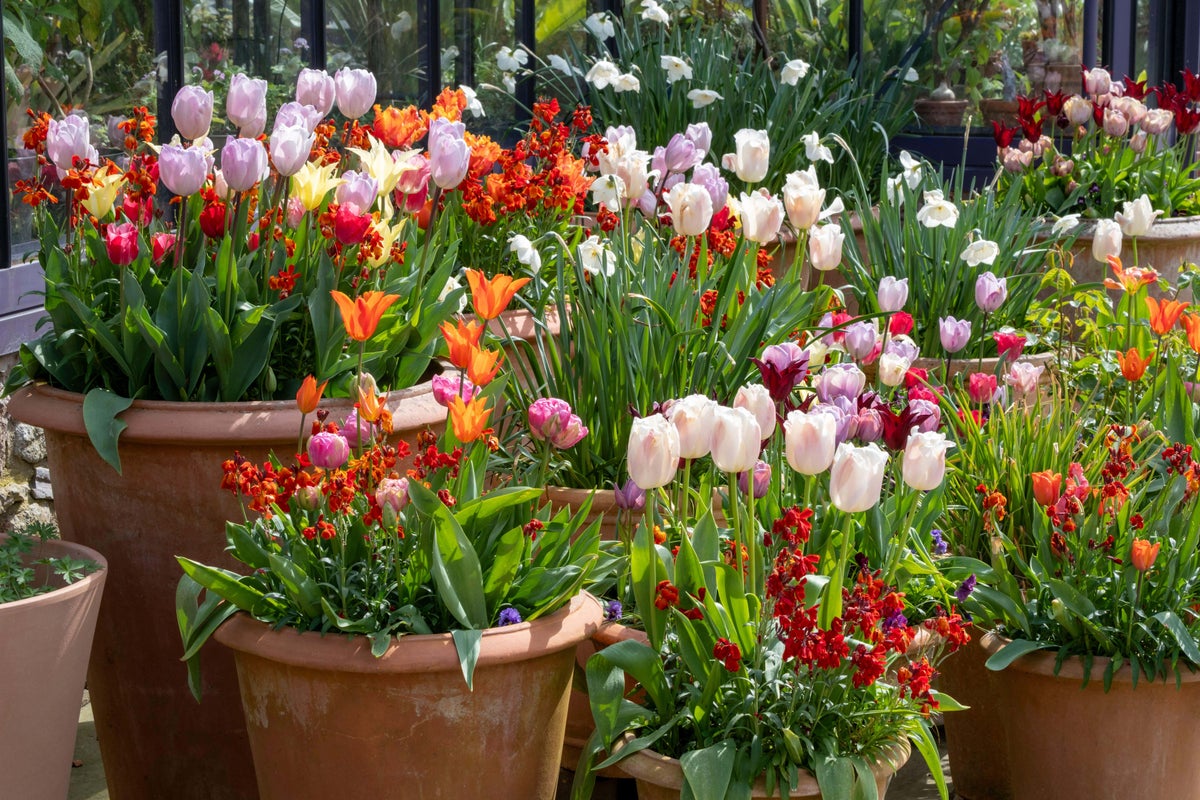
Every spring, gardening expert and author Sarah Raven relishes the fruits of her labours as her container tulips bring a riot of colour to her garden at Perch Hill Farm, East Sussex, where visitors can see the glorious combinations of bulbs during open days from mid-April.
She has now collaborated with renowned creators and designers, including Kim Murray and Gardeners’ World presenter Arit Anderson, to release a new edition of ‘The Collective’, featuring their own autumn planting tulip choices to celebrate the colours they are passionate about.
Whether it’s soft pastels or vibrant oranges, velvet reds, purples and pinks, there is a tulip combination which will brighten up your containers, says Raven, author of A Year Full Of Pots, who runs courses and workshops at Perch Hill and beyond.
Here, she suggests three of her favourite combinations.
1. Pretty pastels
“If you want a pastel palette you probably want them to flower all at the same time. We have a ‘Shells on the Beach’ collection including gentle colours with types like ‘Sanne’, the most amazing pink to apricot, ‘Silver Cloud’, which is a wonderful mauve, and ‘Mango Charm’, again an apricot colour.
These come later so if you want something which comes earlier, try a variety called ‘Mystic van Eijk’, then with that collection you will get a succession of colours that really work.”
2. Pure white
“If you have a shady spot you could go for almost a pure white. I would go for ‘White Valley’, which is one of my favourites, mixed with ‘Purissima’ which are really early and will give you a succession, maybe planted with something like the later flowering ‘White Triumphator’.”
3. Bold and brilliant
“For an incredibly beautiful, bold and brilliant collection of colours, with orange, pink and crimson, a great combination is ‘Mariette’, ‘Sarah Raven’ and ‘Ballerina’, the most lovely scented orange.”
She also recommends ‘Unique de France’, a red variety with glossy leaves which look fantastic in a pot.
Should you mix your plantings?
Some people prefer their pots to contain just tulips to display their true brilliance, others mix them with other plants.
“We tend to plant tulips with something to keep the grey squirrels from eating the bulbs underneath. So we overplant either with edible crops like flat-leaved parsley or hardy salad leaves like rocket or mizuna.
“You could do wallflowers or pansies. In our trials here we found that by over-planting, the grey squirrels don’t smell or notice the bulbs underneath.
“The other thing that works really well is Iris reticulata, the little irises, which flower in February so they precede the tulips but if we are going to do those we put our rose prunings in a noughts and crosses grid over the top of the pot to guard against grey squirrels.
“If you don’t have roses in your garden, take some holly or brambles and use those instead.”
Raven also plants a lot of earlier flowering snowdrops and crocus in her pots which will emerge long before the tulips and lift the garden in February, when low light levels can bring on the winter blues.
“As soon as the snowdrops are done, I take them out of the pot complete with leaves and plant them in the garden.
“With the iris, I take them out with the tulips once they are all done and store them in an onion bag in a barn until the next autumn.”
Planting tips
Unlike some spring bulbs, tulips fare better when planted later in the year, she suggests.
“Compared with alliums, hyacinths and narcissi, tulips start putting down their roots very late. They don’t start putting the bulb under the strain of growth until later than all the other species. The physiology of the plant means that you can plant it last.
“The second reason is that historically when we used to have frost, which with climate change we don’t have so much, it was always thought to be good to have a few hard frosts, which would then kill the tulip blight spores which sit on the surface of the soil.
“That is no longer so relevant because here we don’t get a frost until January in Sussex. With our wet, mild autumns, winters and springs like we had in 2023 and 2024, tulip blight is becoming more of a problem because of the lack of frost.”
Container advice
When planting tulips in containers, plant the bulbs closer than you would in the border, Raven advises.
“In a border you tend to space them one-and-a-half times the diameter of the bulb. In a pot, I would do one times the diameter.”
Don’t worry about watering because it will rain over the winter and they are not coming into growth straight away, she advises.
Be careful about pot hygiene, she adds. If you know you’ve had blight in the pot the previous season, give the pot a wash with a disinfectant to kill the spores.



0 Comments